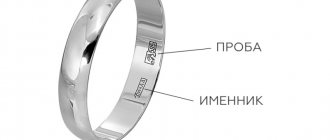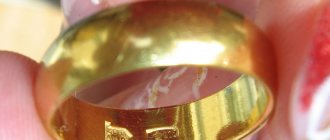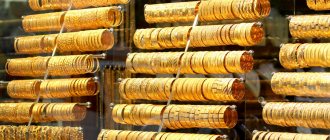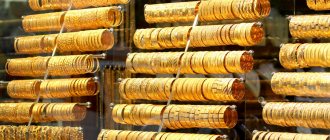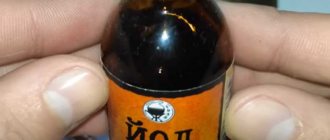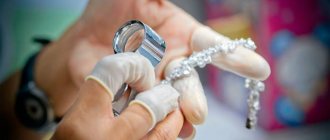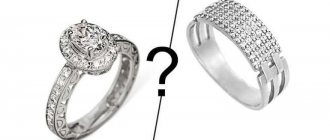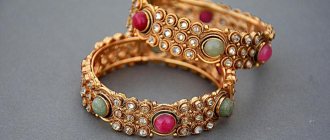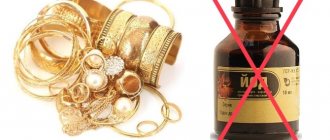How to distinguish gold from fake
The determination of real precious material must be carried out in combination.
- Visual inspection. The product must be marked with a sample or its carat weight. The markings can be easily viewed through a magnifying glass or by taking a photo on a smartphone in macro mode.
- Barcode verification. There are online programs that clearly explain how to check the authenticity of a product. Product tags contain a barcode that can be scanned in the application or entered the code using a special website.
Next, we will consider several ways that will distinguish a fake from the original.
Traditional verification methods
Not every citizen has the opportunity to turn to specialists to check the authenticity of their family jewelry or valuable item.
In jewelry, quality is assessed by the gold content of the product.
Therefore, it is possible to determine the quality of gold at home. This will not require a long time or special financial expenses, and the result can be seen almost immediately, except in cases in which the verification process is slow. These methods have been around for many decades, they have gained popularity, are passed down from generation to generation, and are often used in homes.
For the most part, gold jewelry contains hallmarks of 585 and 583. 585 standard means that the product contains 58.5% gold and 41.5% admixture of other metals.
There are a lot of options for testing gold at home: both with chemicals and using available improvised items, for example, a magnet, vinegar, iodine or using sound.
Iodine test
To determine whether a piece of jewelry is real or gold plated, you will need iodine. This is the most affordable drug that can be taken from your home medicine cabinet. But you need to follow safety precautions so as not to accidentally get burned, since iodine is a chemical substance.
You can remove inspection marks by wiping the jewelry with a cotton swab dipped in a 30% sodium hyposulfite solution.
You need to rub the item to be determined on jeans or any dense fabric to remove dirt, and then apply a drop of iodine to this place with a pipette or cotton swab. Carefully wipe off the excess, wait a few minutes and look at the result:
- High quality gold will not change color.
- If barely noticeable white spots remain, then the product is definitely fake.
- Dark stains will appear on the surface of a product of low quality and will not be washed off with water.
On real gold, a drop of iodine remains dark in color and does not evaporate for a long time.
Such stains can be removed in a solution of soap and ammonia, or traces can be removed by wiping with cotton wool soaked in a 30% solution of sodium hyposulfite - it is freely available in pharmacies. Another way to remove stains is to use regular toothpaste, but in this case there is a risk of erasing part of the finish. If you use ammonia, traces will remain. You can use vinegar essence, but you should act carefully so as not to get burned. If you cannot clean the item yourself, it is better to take it to a specialist for cleaning.
If the place where the iodine was turned black, then this is real gold. On fake jewelry it turns white.
The above method shows very well the testing of high-grade gold. But it is better to use additional methods.
Important! It is not recommended to test with iodine with products of 585 standard and below - stains may remain that are very difficult to remove.
Check in bread
This method is not fast, but it works. You need to take a crumb of fresh black bread, moisten it with water, place the gold product inside the resulting pulp and put it aside for several days in a dark, cool place until it dries completely. When the bread becomes stale and turns into a dry crust, break it and examine the decoration. The gold will not change its tone, but the fake will oxidize and turn green due to mold, giving the crumb a dark color.
The method is safe (for real gold!), but slow.
Testing gold with vinegar
One of the simplest and most accessible ways to distinguish a genuine product from a fake one is table vinegar; it is found in almost every home.
You need to pour a little vinegar, or better yet its essence, into a glass, put a coin or other test sample into it, and wait a few minutes. Fake gold will quickly oxidize and darken, but real gold will retain its color. The solution used will not react with genuine gold. But there is a danger that the liquid will spoil gold jewelry with the addition of other metals, such as silver and pearls.
Fake gold quickly darkens in vinegar - just pour a little into a glass and hold the metal in it for about five minutes.
After checking, in order to wash off the negative effects of the reagent from the product, you should rinse the jewelry with cold water, wipe dry and polish with a piece of suede cloth.
Important! White gold should be tested carefully. Due to its sensitive alloy, some reagents, such as iodine and vinegar, may harm the jewelry.
Tell the seller that you will test the gold with vinegar. Are you nervous? There’s no need to run to the grocery store anymore.
lapis pencil
Lapis pencil is used in medicine; its main antiseptic function is to cauterize warts and papillomas and stop bleeding. But due to the presence of silver nitrate, it can also be used to test gold items, and in this case it will give a certain result.
Lapis does not react with gold, but does react with other metals.
First, you need to wet the product in water and run a pencil over the wet surface a couple of times, and after a few seconds wipe it with cotton wool. There should be no traces left on real gold - silver nitrate will not react with gold, only with fakes - they will darken.
If a trace remains, then the gold is fake or of very low standard. Nothing will happen to genuine metal.
Note! In this testing, an exception is possible: if the jewelry being tested is of low standard, then the composition of gold in it is so small that lapis may simply not detect it.
Touchstone
This method was used to test gold back in ancient times.
A touchstone is a block of uniform, dark-colored shale rock. It contains no compounds of non-ferrous metals, which is why it is resistant to reagents. It is a hard material and is very resistant to acids - if they are present, it will reveal them.
Siliceous shale is considered the safest and most effective method.
- Prepare the stone: clean it with water and charcoal, grease it with vegetable oil and wipe it with filter paper.
- When the processing is completed, they take the product made from the supposed gold and draw a short line along the stone.
- Using special assay needles, small strokes are applied next to the sample number of the product being tested.
- Finally, nitric acid is used and applied across the strokes.
- They monitor the chemical reaction and determine the result based on the color of the stripes. If the alloy oxidizes and the gold line darkens, then the gold is fake or its purity is below 585.
Determining such a sample at home is quite difficult; you need to have special materials and accessories: nitrogen acid, gold chloride and assay needles.
Specialists working in pawn shops often use touchstones in their work.
By smell
A real gemstone has no odor. If the item emits a strong metallic smell, then it is a fake. To be more sure, you should rub the product and smell it again. It is recommended to hold the gold between your palms and rub: all metals, even silver, will leave a characteristic odor on the skin. Gold does not smell of anything because it does not react with most substances.
Gold items should not have a smell. Even silver has a characteristic metallic smell, but gold does not.
Solar method
In sunny weather it is easy to recognize a fake. The only certain conditions in the experiment are direct sunlight and clear weather. Real gold always retains its color in light and shadow, while fake gold noticeably fades and tarnishes in a dark room.
Objects made of real gold shine equally strongly both in the shade and in direct sunlight.
How to determine gold purity
It is convenient to use an electronic detector at home. You can purchase it at a jewelry store at a low price. Used to accurately determine samples from 333 to 750. Values are shown in carats (from 6 to 18).
The chemical method is carried out using reagents.
For samples of 600 and less, gold chloride is used. For higher levels - acid.
The sample is determined by the color of the resulting spot. The brighter it is, the lower the sample. For example, light brown color characterizes sample 585, green - 375. This method is more often used by specialists.
Keeping up with the times: applying chemical reagents
In jewelry stores, as well as in the departments of chemical reagents and laboratory supplies, you can purchase special kits that are used to identify fakes and low-quality products. Such preparations allow you to quickly check gold for authenticity using nitric and other acids with which the precious metal does not react. Just apply the product to the product and evaluate the result.
If the color has not changed, the jewelry is gold; if it has changed slightly, the alloy contains a certain amount of impurities, and the fake will immediately become covered with noticeable stains. Modern fraudsters can be incredibly skillful, so even passing all home tests does not guarantee that the item is valuable.
Jewelers claim that it is impossible to reliably determine the authenticity of a metal using iodine, brilliant green and other folk methods. Only a professional can accurately check whether gold is real, using a touchstone or modern equipment that is equipped in banks and jewelry stores with a good reputation.
Video on the topic
What is the difference between gold and gilding
Gilding - metal coated with a layer
gold. Different countries have certain requirements for the manufacture of gold-plated products.
On the market you can often find gold-plated jewelry, which is based on silver or an alloy of metals.
The concept of medical gold appeared thanks to marketing tricks. The alloy can be coated with a thin layer of gold, and sometimes can be made without it. The medical alloy is hypoallergenic and durable. Additional coating only decorates the product.
How to avoid becoming a victim of scammers
To avoid purchasing a counterfeit, follow the rules:
- Choose reliable stores. Avoid pawn shops, small shops, markets.
- Demand quality certificates, do not believe the seller who convinces that in some countries the sample is not taken. This is not possible when crossing the border.
- Sellers sell an alloy of titanium and gold. This combination does not contain gold.
- Sample 583. It comes from Soviet times and is no longer produced. Therefore, you can trust such products and their quality.
- Price. An expensive item is not always of high quality. The cost depends on the country of manufacture, weight, size of the product, and complexity of the jewelry work.
- The most popular samples are 585, 750. You cannot trust samples on the Turkish market. They are often not related to reality.
- A poorly printed sample print, chips, scratches and roughness are an indicator of low quality or a fake.
There are situations when the seller only gives the clasp for evaluation. They test it, but the earring may not be real. You can confidently tell a dubious seller that you will test the product with vinegar. If he does not agree, then the product is a fake.
Visual inspection
If you carefully examine the product, you can find signs of low-quality metal.
On many pieces of jewelry, such as a bracelet or chain, you may notice a slight discoloration at the junction of the links. This means that gold of a higher standard was used in the soldering process of the jewelry. It is soft, melts easily and is great for joining and securing small parts. If the difference in color is noticeable and the fold is painted in a bright yellowish tint, then the gold is real. And if the material of the jewelry is homogeneous, then it is costume jewelry that will discolor over time.
If you buy gold secondhand or from an unverified store, use as many methods as possible to ensure the authenticity of the product.
If the new jewelry has scratches and abrasions, this also indicates a poor quality item. The polish should be shiny. Large pores on gold indicate that it was made from a low-quality alloy or that the polishing was carried out incorrectly.
The outer coating and spraying are uniform and uniform, without cracks or scratches.
If there is a stone on the product, it must be firmly attached and not loosen.
Particular attention should be paid to the inside of the item - it should be as smooth to the touch as the outside.
The shade of the object also gives a visual idea of which alloy predominates: if red - then copper, green - silver and cadmium, gray color indicates the excess of steel metal. Platinum and silver together give a white color, and silver and copper give a yellow color.
The visual method is convenient if you do not have the appropriate equipment at hand.
